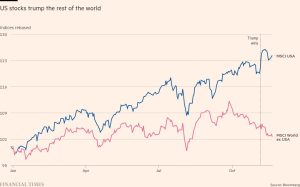First instincts vs second thoughts, which side are you on?
Unlock the Editor’s Digest for free
Roula Khalaf, Editor of the FT, selects her favourite stories in this weekly newsletter.
A first impression suggests that there is nothing to be gained from reading Alex Bellos’s new book of puzzles, Think Twice, except an hour or so of pleasant diversion. But as the book makes clear, first impressions can be misleading.
Bellos is offering a very particular kind of puzzle: the kind where there is an obvious answer, and the obvious answer is wrong.
One might describe such puzzles as “trick questions”, but this is no mere frippery. It is hard to think of a conundrum that offers us more practical lessons than the trick question.
For example: which teapot holds more, a tall elegant one, or a squat but slightly wider pot? The answer: look at where the spout ends. The teapot can tower as high as you like, but if the opening of the spout is low down, you won’t find it carrying much tea. The appearance of a grand scale can be deceptive: the lesson is to look for the weakest link in any system.
Or try this one: “Jack is looking at Anne, but Anne is looking at George. Jack is married, but George is not. Is a married person looking at an unmarried person?” That’s multiple choice: yes, no or cannot be determined.
Bellos set this one to grizzled veterans of his newspaper puzzle column, and warned them they’d get it wrong. Seventy-two per cent of them did — worse than the proverbial dart-throwing chimp. The psychologist Keith Stanovich has found that the typical failure rate on that puzzle is even higher, at more than 80 per cent.
Or, a classic of the genre: Agatha and Zoe have a combined age of 50. Agatha is 40 years older than Zoe. How old is Zoe?
That one is absurdly easy if you take a moment to stop and think. Many people don’t and blurt that Zoe is 10 years old. But why would they hesitate anyway? Our minds are machines for reaching swift conclusions in a fast-moving world. Slowing down to reason in fine detail takes an effort of will.
Still, sometimes it pays to stop and think again. Consider the problem facing countless students as they sit multiple-choice exams, writing down an answer and then having second thoughts. Should they stick with their first instincts or should they switch?
There is an overwhelming consensus on this question. Students, instructors and even some exam guides warn the hesitating candidate to stick with their first thought. “Many students who change answers change to the wrong answer,” admonishes one guide — which, when you think about it, may be true but is also not a good basis for advising students not to change.
While the consensus may be overwhelming, it is quite wrong. A century of academic research into the question demonstrates clearly that when you have second thoughts on a multiple-choice test, it’s a good idea to change your answer. Indeed, the gap between our beliefs and the evidence is so stark that psychologists have given it a name: the “first-instinct fallacy”.
Our first instincts are often right, to be sure. But when we have second thoughts, that’s a sign of trouble: second thoughts usually occur to us for a reason.
Why are we so reluctant to indulge our second thoughts? Psychologists Derrick Wirtz, Dale Miller and Justin Kruger (he of the Dunning-Kruger effect) have conducted experiments showing that we tend to misremember the results of switching answers. We tend to recall times when switching was a mistake, and overestimate how often we got good results from sticking to our first guess. The same researchers also found evidence that people were frustrated by teammates in a quiz game who switched answers, regardless of their overall performance in the game.
And this research on the first-instinct fallacy presumes that the second thoughts even occur. All too often, they do not. Bellos’s book challenges readers to think twice (the clue is in the title), and yet many still stumble into the cognitive traps he sets. When an answer leaps into our heads and feels right, it is easy to mistake that feeling for the truth.
As we step away from multiple-choice questions and puzzle books and into the everyday information environment of media and social media, we are endlessly being confronted with claims that feel intuitively true (or intuitively absurd) and leaping to conclusions. One is rarely warned to think twice on X or Facebook, but the warning would be useful nevertheless.
This is not mere speculation: Gordon Pennycook, David Rand and others, behavioural scientists who study misinformation and how we respond to it, have found that people who do poorly with tricky puzzle questions (the term of art is “cognitive reflection problems”) are more likely to share online misinformation and they are also more likely to fall for falsehoods of a politically partisan nature.
That’s a striking finding: it suggests that spotting fake news is more a matter of calm reflection than it is of raw intelligence or technical expertise. An encouraging finding, too — if only we can find a few oases of calm on the internet.
Follow @FTMag to find out about our latest stories first and subscribe to our podcast Life and Art wherever you listen
#instincts #thoughts #side



